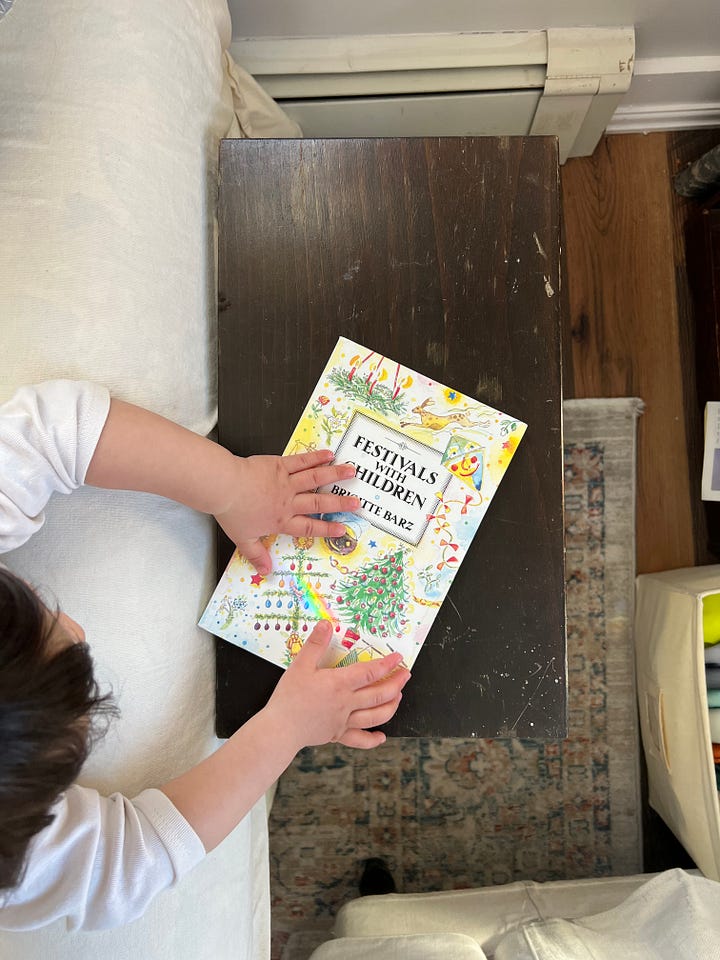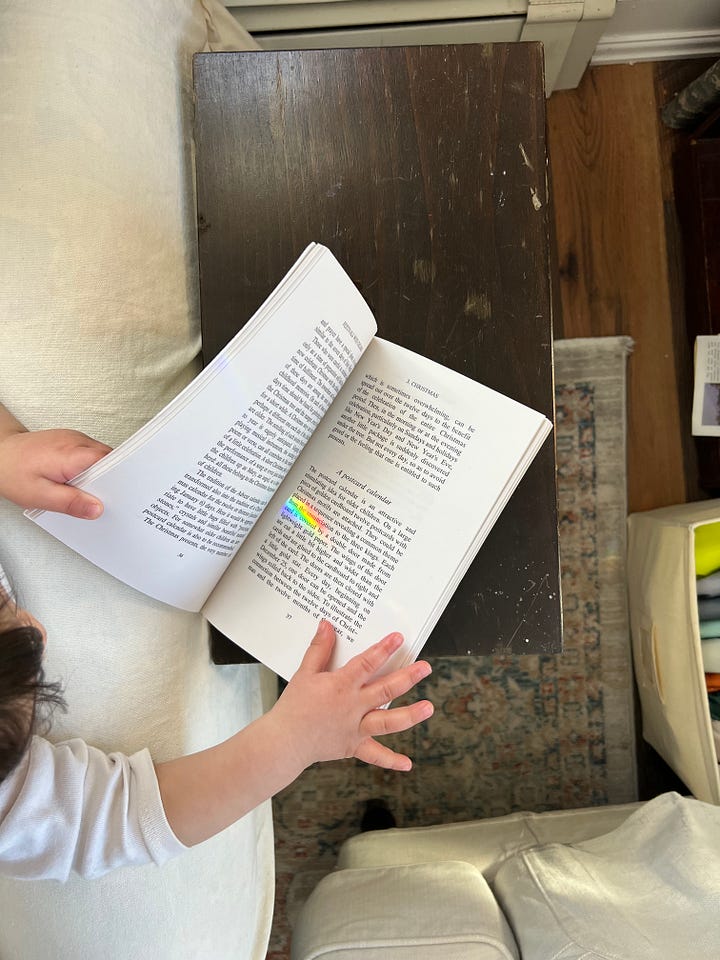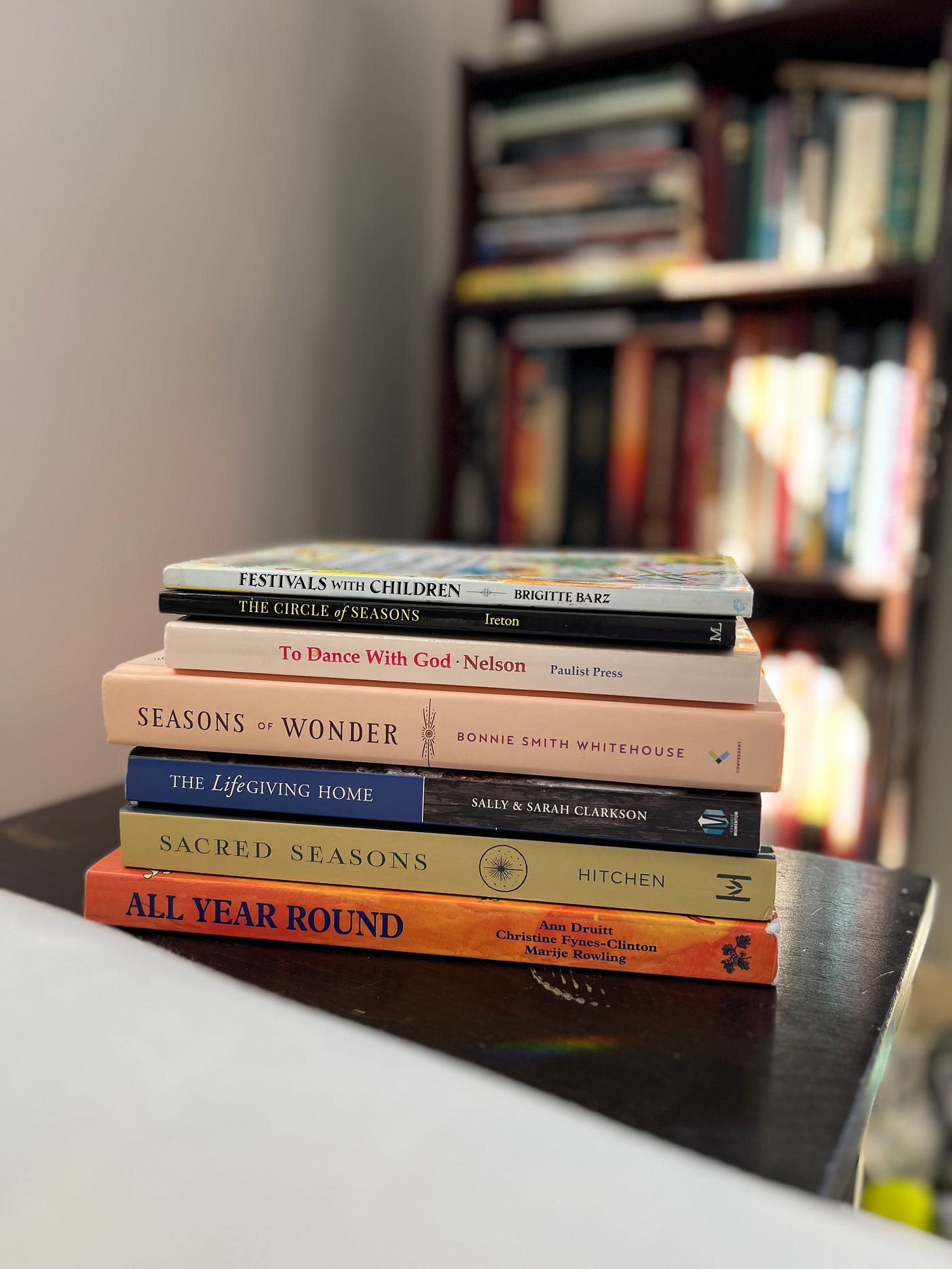Back to Basics for Lent, Easter, and Pentecost
The core elements of celebration, plus a liturgical living book stack
Dear friends,
A few weeks ago, out of desperation, I searched for another book or two to keep my children somewhat seated in the pew. That particular Sunday morning was awash with slush and freezing rain resulting in an empty nursery. I found several suitable books and crayons, but also fished out a small book from the lobby shelf that instantly caught my eye.
Several years into my liturgical era, as many mothers of small children do, I gravitate towards anything with the key words tradition, festivals, liturgy, home, or seasonal in the title. Festivals with Children by Brigitte Barz just about threw itself at me. In less than 100 pages the author covers the liturgical year, Advent to Whitsun to Hallowe’en. To my delight she also includes festivities for Ascension, St. John’s Tide, Michaelmas, and Martinmas. Her approach is widely relevant, while also addressing ideas of interest to families or teachers within the Waldorf educational philosophy.
I’ll eat up large volumes related to the liturgical calendar any day but often less is more. Principles, rather than formulas, related to sacred time set wide table on which folks can place their own experiences, longings, and interpretations. Festivals with Children, and other small books like The Circle of Seasons, offer essential themes and some commentary without the cascade of extras. Don’t get me wrong, some of my favorite books are full of recipes, whimsical crafts, and endless activities. However, these slender titles offer their work with the confidence readers have more than enough creativity and thoughtfulness for meaningful celebrations in their personal context.


Barz’s introduction highlights the common ingredients of these open ended celebrations: A table, cloth or textiles, images, natural elements, candles, poems and songs, and a story. Gertrud Mueller Nelson adds in paradox, imagination, sounds, emotions, and food, among others in her book — an all-time favorite — To Dance with God. Both authors use the rest of their books to suggest how these can be applied to observe liturgical feasting and fasting. These ingredients are ready and waiting to carry the joy of birthdays to the longings of Lent.
I mention all this on the cusp of the Easter cycle: Lent, Easter, and Pentecost. In all honesty, this portion of the calendar does not spark the same joy for me as Advent, Christmas, and Epiphany, or the Christmas cycle. There’s all kinds of reasons I’m sure. Death is not as particularly inviting as new birth. The fifty days of Eastertide, once the most important Christian holiday, can easily lose steam after the first Monday. Not to mention Ascension and Pentecost Sundays often fly under the radar.
Eastertide is otherworldly. The Easter cycle is tethered to the cosmic rhythms of the moon rather than fixed dates. She requires flexibility, attentiveness, and the humility to consider the unknowns. She prods into the parts of our inner landscape we might rather keep out of view. Our mortality is one thing, our sin or our need for divine restoration is another. The ego takes a hit. Christ is no longer just a historical rabbi on earth, but a resurrected reality that lends itself to more controversy than answers. The early church barely came to a single consensus on what it all meant.
Thousands of years later we still wrestle with the Christ story. As much as the traditions of the liturgical year can infuse texture and perspective into our story of faith, they don’t guarantee any more clarity. And, in my experience, they can become distractions on the spiral journey of sacred time if we overcomplicate them. Remember, this is principle over prescription. The core elements of celebration mentioned above exist to enliven our hearts, not burden them. By returning to simplicity with childlike trust we open ourselves to the Spirit’s work each time we learn from the stories of Christ.
In a few days we’ll embark on a new cycle of preparation, celebration, and proclamation through Lent, Easter, and Pentecost. Take a quick inventory of what’s already in your house. Borrow a book of poetry from the library. Reuse the remaining purple candles from Advent. Put some colored pencils and paper in the car for easy nature journaling. Gather foliage from your yard to display in a vase or on the table. Write a simple breath prayer. Whatever you have, it’s plenty.
Tell me, do you have any traditions for these holidays? What makes them special?
(P.S. Mark you calendar! Shrove Tuesday, or Pancake Tuesday, is March 4th; Ash Wednesday is March 5th.)
7 Lovely Books on Seasonal Traditions
As an added bonus, here are a few of the books I reference throughout the year. These are my cream of the crop, but you can find more here.
Festivals with Children by Brigitte Barz (Out of print, sadly.)
The Circle of Seasons: Meeting God in the Church Year by K.C. Ireton
To Dance with God: Family Ritual and Community Celebration by Gertrud Mueller Nelson
The Lifegiving Home: Creating a Place of Belonging and Becoming by Sally and Sarah Clarkson
Sacred Seasons: A Family Guide to Center Your Year Around Jesus by Danielle Hitchen, Stephen Crotts
All Year Round: A Calendar of Celebrations by Ann Druitt, Christine Fynes-Clinton, Marije Rowling
What books have encouraged you?
(Quick note. These resources contain affiliate links which means I may earn a small commission when you purchase any of these recommendations from Bookshop.)
Related Resources:
Here’s a collection of 10 guided lectio divinas for Lent.
Still need a liturgical calendar for the year? Find one in the Library.
Write (or refresh) your Rule of Life with this three part video series.






I really appreciate these practical tips. Lent and Easter always creep up on me, and I feel unprepared. This feels like a nudge from the Lord today. Thank you!